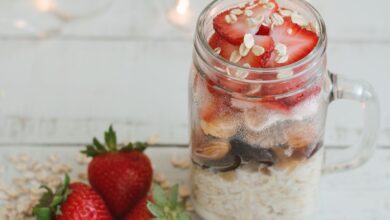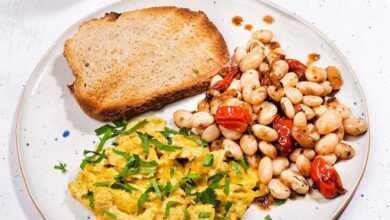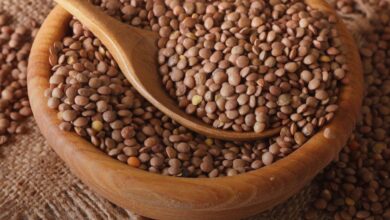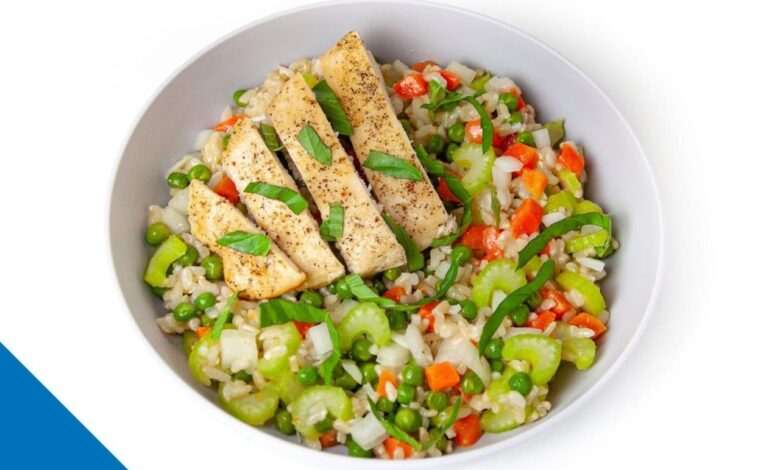
Grain Bowls with 400 Calories or Less: Healthy and Delicious
Grain bowls with 400 calories or less are a fantastic way to enjoy a satisfying and nutritious meal without breaking the calorie bank. These bowls are packed with flavor, texture, and nutrients, making them a perfect choice for anyone looking for a healthy and delicious lunch or dinner option.
The beauty of grain bowls lies in their versatility. You can customize them with your favorite ingredients, ensuring that each bowl is unique and tailored to your preferences. Whether you’re a vegetarian, vegan, or simply looking for a light and flavorful meal, grain bowls offer endless possibilities.
Grain Bowls: A Delicious and Calorie-Conscious Choice
Grain bowls have become increasingly popular in recent years, offering a versatile and satisfying meal option. Their popularity can be attributed to their ability to accommodate a wide range of ingredients, making them customizable to individual preferences and dietary needs.
They are also perceived as a healthier alternative to traditional fast food options, often featuring fresh vegetables, lean proteins, and wholesome grains. While grain bowls can be a healthy choice, it’s important to be mindful of calorie intake, especially if you are watching your weight or following a specific diet plan.
This is where calorie-conscious grain bowl recipes come in handy. This article explores grain bowls with 400 calories or less, providing you with delicious and nutritious meal options that won’t break the bank.
Calorie-Conscious Grain Bowls: A Guide to Delicious and Healthy Meals
A calorie-conscious grain bowl can be a satisfying and nutritious meal option, offering a balanced combination of carbohydrates, protein, and healthy fats. Here are some tips for creating calorie-conscious grain bowls:
- Choose Whole Grains:Opt for whole grains like brown rice, quinoa, or farro, which are higher in fiber and nutrients than refined grains. These grains are also more filling, helping you feel satisfied for longer.
- Incorporate Lean Proteins:Include lean protein sources like grilled chicken, fish, tofu, or beans. These provide essential amino acids and help to keep you feeling full.
- Load Up on Vegetables:Vegetables are low in calories and packed with vitamins, minerals, and fiber. Use a variety of colorful vegetables to add flavor and nutrients to your bowl.
- Use Healthy Fats:Include a small amount of healthy fats like avocado, nuts, or seeds. These fats provide essential nutrients and help to improve satiety.
- Control Portions:Be mindful of portion sizes. A typical grain bowl should contain about 1 cup of cooked grain, 4 ounces of protein, and 1 cup of vegetables.
Grain Bowl Basics
Grain bowls are a versatile and delicious way to enjoy a balanced and satisfying meal. They are essentially a blank canvas, allowing you to create endless combinations based on your preferences and dietary needs. The key to a well-constructed grain bowl lies in its essential components: grains, protein, vegetables, and dressing.
Each component plays a crucial role in creating a complete and fulfilling meal. The grains provide complex carbohydrates for sustained energy, the protein offers satiety and supports muscle growth, the vegetables deliver essential vitamins, minerals, and fiber, and the dressing adds flavor and moisture.
Grain Choices
The foundation of any grain bowl is the grain itself. Choosing the right grain can significantly impact the nutritional profile and overall flavor of your bowl. Here are some popular and versatile options:
- Quinoa:A complete protein source, meaning it contains all nine essential amino acids. Quinoa is also a good source of fiber, iron, and magnesium.
- Brown Rice:A whole grain rich in fiber, manganese, and selenium. Brown rice is a good source of complex carbohydrates, providing sustained energy.
- Farro:An ancient grain with a nutty flavor and chewy texture. Farro is a good source of fiber, protein, and iron.
- Barley:A high-fiber grain with a slightly sweet flavor. Barley is a good source of beta-glucan, a soluble fiber that may help lower cholesterol levels.
Protein Options
Protein is an essential nutrient for building and repairing tissues, maintaining a healthy immune system, and keeping you feeling full and satisfied. When choosing protein sources for your grain bowls, opt for lean options that are low in calories and high in nutritional value.
Lean Chicken
Lean chicken is a great source of protein, providing about 27 grams per 3-ounce serving. It’s also a good source of essential nutrients like niacin, vitamin B6, and selenium. Chicken breast is generally considered the leanest cut, with about 165 calories per 3-ounce serving.
Grain bowls are a fantastic way to enjoy a healthy and satisfying meal, especially when you’re looking for something under 400 calories. But with so many different options out there, it can be tough to know where to start.
That’s where a registered dietitian can come in handy! They’re the experts in food and nutrition, and they can help you create a meal plan that fits your individual needs and goals. To learn more about the difference between a nutritionist and a registered dietitian, check out this helpful article: ask the rd whats the difference between a nutritionist and registered dietitian.
With the right guidance, you can easily create delicious and nutritious grain bowls that will keep you feeling full and energized all day long.
Tofu
Tofu is a plant-based protein source made from soybeans. It’s low in calories, with about 80 calories per 3-ounce serving, and is a good source of iron, calcium, and manganese. Tofu can be marinated and grilled, crumbled into salads, or added to stir-fries.
Beans
Beans are a versatile and affordable source of protein. They are also rich in fiber, which can help you feel full and satisfied. Black beans, kidney beans, and chickpeas are excellent choices for grain bowls. One cup of cooked beans provides about 15 grams of protein and only about 230 calories.
Lentils
Lentils are another excellent source of plant-based protein, providing about 18 grams per cooked cup. They are also rich in fiber, iron, and folate. Lentils can be added to soups, stews, or salads, or used as a base for grain bowls.
Grain bowls are a great way to get a healthy and satisfying meal in under 400 calories, and they’re incredibly versatile. You can experiment with different grains, veggies, and protein sources to create endless combinations. For a hearty and warming twist, consider incorporating chili as your protein source! Check out these 10 easy chunky chili recipes under 360 calories for inspiration.
Once you’ve got your chili base, simply assemble your bowl with your favorite grains, veggies, and a sprinkle of cheese or avocado for a complete and delicious meal.
Tips for Incorporating Protein
Here are some tips for incorporating protein into your grain bowls in a satisfying and flavorful way:
- Marinate and grill lean chicken or tofu.Marination adds flavor and moisture to the protein.
- Crumble cooked chicken, tofu, or beans over your grain bowl.This is a quick and easy way to add protein to your meal.
- Roast chickpeas or lentils for a crispy and flavorful addition to your bowl.
- Top your grain bowl with a poached egg.A poached egg provides a boost of protein and adds a creamy texture to your bowl.
- Use a variety of protein sources.This will help you ensure that you are getting a balanced intake of nutrients.
Vegetable Variety
The beauty of grain bowls lies in their versatility. They offer a blank canvas for incorporating a wide array of vegetables, adding both flavor and nutritional value.
Choosing vegetables based on seasonality ensures freshness and optimal flavor, while personal preferences allow you to create bowls that cater to your tastes. Experiment with different combinations and discover new favorites!
Grain bowls are a fantastic way to enjoy a satisfying and healthy meal, especially during the summer. They’re packed with nutrients and can easily be customized to fit your dietary needs. To stay on track with your healthy eating goals during the warmer months, check out these healthy eating tips for summer to keep in track.
With a little creativity, you can easily create grain bowls with 400 calories or less that are both delicious and nutritious.
Vegetable Options, Grain bowls with 400 calories or less
Here’s a table highlighting some popular vegetables for grain bowls, along with their calorie counts, nutritional benefits, and preparation tips:
| Vegetable | Calories per Serving (1 cup) | Nutritional Benefits | Preparation Tips |
|---|---|---|---|
| Broccoli | 34 calories | Rich in vitamin C, vitamin K, and fiber. Also contains antioxidants. | Steam, roast, or sauté broccoli florets. Add chopped broccoli to stir-fries or salads. |
| Bell Peppers | 29 calories | Good source of vitamin C, vitamin A, and antioxidants. | Roast, grill, or sauté bell peppers. Slice them for salads or stuff them with fillings. |
| Spinach | 7 calories | High in vitamin A, vitamin K, and iron. Also contains antioxidants. | Add spinach to salads, smoothies, or sauté it with garlic and olive oil. |
| Carrots | 50 calories | Excellent source of vitamin A, potassium, and fiber. | Roast, steam, or julienne carrots for salads. |
| Cucumber | 16 calories | Low in calories and rich in vitamin K, vitamin C, and antioxidants. | Slice cucumbers for salads or add them to dips. |
| Avocado | 160 calories | High in healthy fats, fiber, and potassium. | Slice avocado for salads, toast, or use as a dip. |
| Sweet Potato | 180 calories | Excellent source of vitamin A, fiber, and potassium. | Roast, mash, or bake sweet potatoes. |
| Zucchini | 17 calories | Rich in vitamin C, vitamin K, and fiber. | Sauté, grill, or spiralize zucchini for salads. |
| Green Beans | 25 calories | Good source of vitamin C, vitamin K, and fiber. | Steam, roast, or sauté green beans. |
Dressing Choices
The dressing is the final touch that brings all the flavors of your grain bowl together, and choosing the right one can make or break your meal. While it’s tempting to reach for creamy, indulgent dressings, opting for lighter and healthier options can keep your calorie count in check without sacrificing flavor.
Here’s why focusing on healthy dressings is important:
Low-Calorie Dressing Options
Low-calorie dressings can be just as flavorful and satisfying as their heavier counterparts. Some great options include:
- Light Vinaigrette:A simple blend of oil, vinegar, and seasonings, light vinaigrette is a classic choice for grain bowls. Look for versions made with olive oil and balsamic vinegar, which offer a tangy and slightly sweet flavor profile.
- Lemon Juice:A natural source of acidity and flavor, lemon juice can brighten up your grain bowl without adding any calories. Combine it with herbs like dill or parsley for a refreshing and light dressing.
- Herbs:Fresh herbs like basil, cilantro, mint, and oregano can add a burst of flavor to your grain bowl. Combine them with a small amount of olive oil and lemon juice for a simple and healthy dressing.
Homemade Dressings
Making your own dressings allows you to control the ingredients and calorie content. Here are some tips for creating delicious and healthy homemade dressings:
- Start with a base:Choose a base like olive oil, vinegar, or lemon juice. You can also use yogurt or tahini for a creamy texture.
- Add flavor:Experiment with different herbs, spices, and seasonings to create your own unique dressing. Consider using garlic, ginger, chili flakes, or Dijon mustard.
- Adjust the consistency:Add water or vinegar to thin out the dressing, or use a blender to create a smooth emulsion.
Tips for Success: Grain Bowls With 400 Calories Or Less
Grain bowls are incredibly versatile, offering a fantastic opportunity to create meals that align with your preferences and dietary needs. By embracing a little planning and a touch of creativity, you can effortlessly transform grain bowls into a regular fixture in your culinary repertoire.
Planning and Preparation
Planning ahead is key to ensuring your grain bowls are both delicious and convenient. Here’s how you can streamline the process:
- Cook Grains in Bulk:Prepare a large batch of your favorite grains, such as quinoa, brown rice, or farro, on the weekend. This will provide a ready-to-use base for your grain bowls throughout the week.
- Chop Vegetables in Advance:Prepping your vegetables ahead of time can save you valuable time during busy weeknights. You can chop vegetables like bell peppers, onions, carrots, or broccoli and store them in airtight containers in the refrigerator for up to 3 days.
- Prepare Protein Portions:Cook a large batch of protein, such as grilled chicken, baked tofu, or lentils, to use throughout the week. This will ensure you always have a healthy protein source readily available.
Storing and Reheating
Storing and reheating your grain bowls correctly will help maintain their freshness and flavor:
- Refrigerate Properly:Store your grain bowls in airtight containers in the refrigerator for up to 3 days. Separate the components (grains, vegetables, protein, and dressing) to prevent the vegetables from becoming soggy.
- Reheat Effectively:Reheat your grain bowls in the microwave or oven. If using the microwave, cover the bowl with a damp paper towel to prevent drying. For oven reheating, bake at 350°F (175°C) for 15-20 minutes.
Experiment and Customize
The beauty of grain bowls lies in their flexibility. Embrace your inner culinary explorer and experiment with different ingredients and combinations to create your own unique and delicious grain bowls. Here are some ideas to get you started:
- Explore Diverse Grains:Venture beyond quinoa and rice. Experiment with other grains like barley, wild rice, or freekeh. Each grain offers a unique texture and flavor profile.
- Embrace Seasonal Produce:Incorporate seasonal fruits and vegetables into your grain bowls. Not only will this provide a burst of freshness, but it will also ensure you’re getting the most nutrient-rich ingredients.
- Play with Flavors:Experiment with different dressings, sauces, and spices. Consider using a tangy vinaigrette, a creamy tahini dressing, or a spicy sriracha mayo.
Final Review
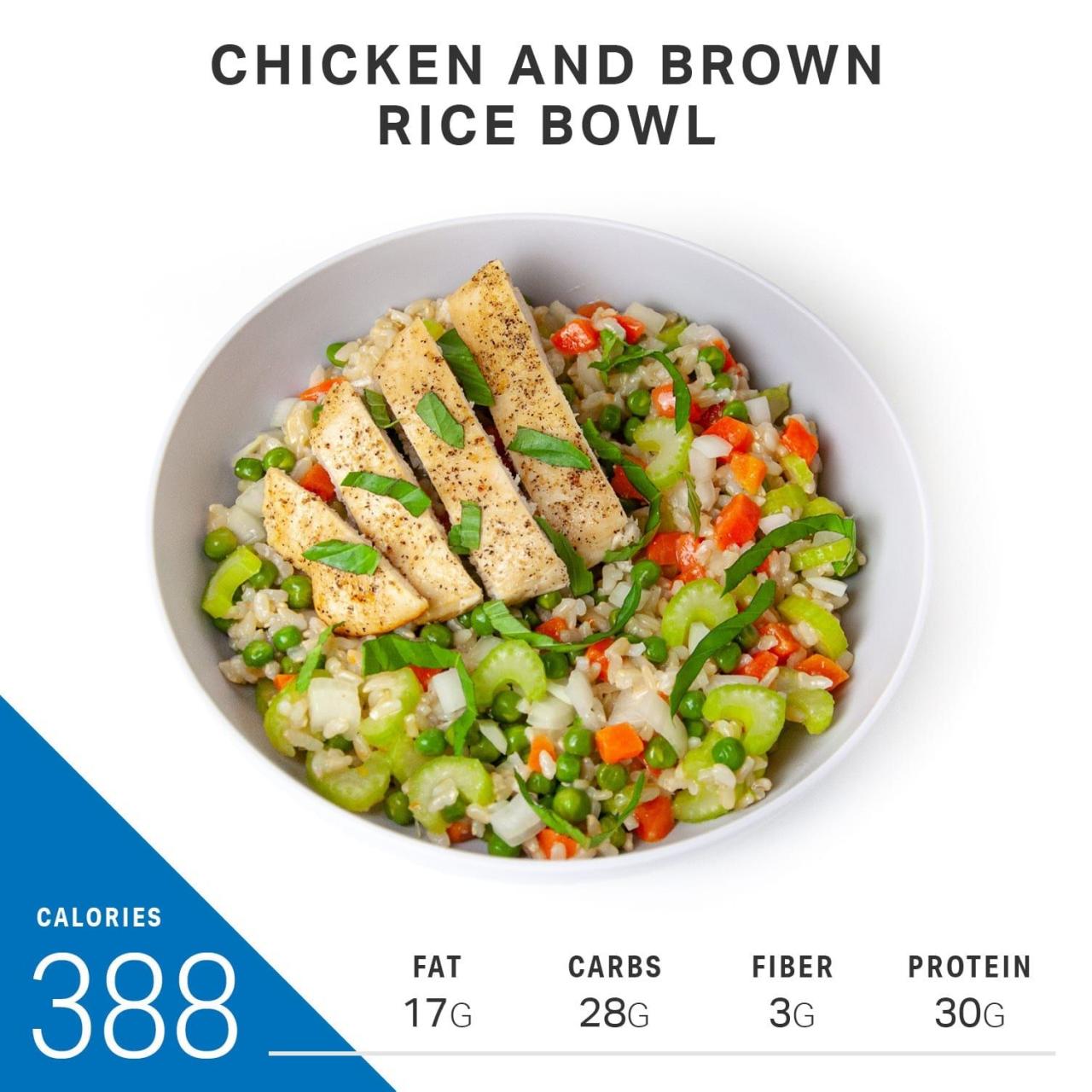
With their flexibility, nutritional value, and deliciousness, grain bowls with 400 calories or less are a fantastic addition to any healthy eating plan. By embracing the principles of balance and mindful portion control, you can create a symphony of flavors and textures that will leave you feeling satisfied and energized.
So, unleash your creativity, experiment with different ingredients, and discover the joy of crafting your own personalized grain bowl masterpiece.


